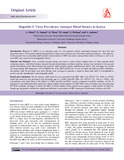| dc.contributor.author | Mutai, A. | |
| dc.contributor.author | Songok, E. | |
| dc.contributor.author | Muna, Kennedy K. | |
| dc.contributor.author | Langat, B. | |
| dc.contributor.author | Boriang, J. | |
| dc.contributor.author | Andonov, A. | |
| dc.date.accessioned | 2022-11-03T15:39:41Z | |
| dc.date.available | 2022-11-03T15:39:41Z | |
| dc.date.issued | 2022-10-01 | |
| dc.identifier.citation | Annals of Pathology and Laboratory Medicine (APALM), Vol 9 No 9 (2022) | en_US |
| dc.identifier.uri | https://www.pacificejournals.com/journal/index.php/apalm/article/view/3193/2080 | |
| dc.identifier.uri | http://hdl.handle.net/123456789/6144 | |
| dc.description.abstract | Introduction: Hepatitis E (HEV) is an emerging cause of viral hepatitis mainly transmitted through the fecal-oral and parenteral routes. It has greatly affected populations in many parts of Kenya due to declined sanitation practices. The objective of the research was to determine IgM and IgG seroprevalence of HEV prevalence among blood donors in Kenya as well as its Anti-HEV sero-reactivity by demographic factors.
Material and Methods: Cross sectional research design was used to collect blood samples from six from regional blood collecting centers, with blood donors selected through proportionate stratified sampling. Serum were matched to the age and gender distribution of the blood donors and tested by IgM and IgG enzyme immunoassays (EIA). The screening was carried out using human MP Diagnostics (0721150096T-96 wells) HEV ELISA kit. To test for IgM and IgM anti-HEV antibodies, microplates with 96-well plate were used. Results were averaged to generate a signal-to-noise ratio with ≥1.0 designated as positive per the manufacturer’s recommended cutoff.
Result and Conclusion: On the analysis, IgM reactivity was associated with HEV (RR 1.66, 95%CI 1.07, 2.60; p = 0.024) while IgG reactivity was associated with increasing age (p < 0.001) and HIV (RR 1.93, 95%CI 1.52, 2.46; p < 0.001). AFI case-patients were more likely to be IgM (p = 0.002) and IgG (p<0.001) reactive compared to healthy residents. All the 19 hepatitis E virus IgM and/or IgG seropositive blood samples tested negative for HEV RNA since no bands were detected using RT-PCR technique. Serologic evidence for HEV in blood samples from selected areas suggests a high burden of infection, though age and gender exhibited no significant difference in prevalence of HEV among the blood donors in Kenya (p>0.05). | en_US |
| dc.language.iso | en | en_US |
| dc.subject | Hepatitis E, Seroprevalence, Blood donors, Endemic | en_US |
| dc.title | Hepatitis E Virus Prevalence Amongst Blood Donors in Kenya | en_US |
| dc.type | Article | en_US |

